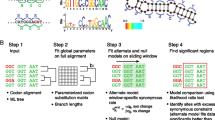Abstract
Molecular evolutionary analyses were carried out to elucidate the phylogenetic relationships, the evolutionary rate, and the divergence times of hepatitis C viruses. Using the nucleotide sequences of the viruses isolated from various locations in the world, we constructed phylogenetic trees. The trees showed that strains isolated from a single location were not necessarily clustered as a group. This suggests that the viruses may be transferred with blood on a worldwide scale. We estimated the evolutionary rates at synonymous and nonsynonymous sites for all genes in the viral genome. We then found that the rate (1.35 × 10−3 per site per year) at synonymous sites for the C gene was much smaller than those for the other genes (e.g., 6.29 × 10−3 per site per year for the E gene). This indicates that a special type of functional constraint on synonymous substitutions may exist in the C gene. Because we found an open reading frame (ORF) with the C gene region, the possibility exists that synonymous substitutions for the C gene are constrained by the overlapping ORF whose reading frame is different from that of the C gene. Applying the evolutionary rates to the trees, we also suggest that major groups of hepatitis C viruses diverged from their common ancestor several hundred years ago.
Similar content being viewed by others
References
Alter HJ (1989) Chronic consequences of non-A, non-B hepatitis. In: Seeff LB, Lewis JH (eds) Current perspectives in hepatology. Plenum Medical, New York, pp 83–97
Alter HJ, Purcell RH, Shih JW, Melpolder JC, Houghton M, Choo Q-L, Kuo G (1989) Detection of antibody to hepatitis C virus in prospectively followed transfusion recipients with acute and chronic non-A, non-B hepatitis. N Engl J Med 321:1494–1500
Chan S-W, McOmish F, Holmes EC, Dow B, Peutherer JF, Follett E, Yap PL, Simmonds P (1992) Analysis of a new hepatitis C virus type and its phylogenetic relationship to existing variants. J Gen Virol 73:1131–1141
Chen P-J, Lin M-H, Tai K-F, Liu P-C, Lin C-J, Chen D-S (1992) The Taiwanese hepatitis C virus genome: sequence determination and mapping the 5′ termini of viral genomic and antigenomic RNA. Virology 188:102–113
Choo Q-L, Kuo G, Weiner AJ, Overby LR, Bradley DW, Houghton M (1989) Isolation of a cDNA clone derived from a blood-borne non-A, non-B viral hepatitis genome. Science 244:359–362
Choo Q-L, Richman K, Han JH, Berger K, Lee C, Dong C, Gallegos C, Coit D, Medica-Selby A, Barr PJ, Weiner AJ, Bradley DW, Kuo G, Houghton M (1991) Genetic organization and diversity of the hepatitis C virus. Proc Natl Acad Sci USA 88:2451–2455
Enomoto N, Takada A, Nakao T, Date T (1990) There are two major types of hepatitis C virus in Japan. Biochem Biophys Res Commun 170:1021–1025
Felsenstein J (1985) Confidence limits on phylogenies: an approach using the bootstrap. Evolution 39:783–791
Fuchs K, Motz M, Schreier E, Zachoval R, Deinhardt F, Roggendorf M (1991) Characterization of nucleotide sequences form European hepatitis C virus isolates. Gene 103:163–169
GenBank Release 71.0 (1992) IntelliGenetics Inc, California
Gojobori T, Ishii K, Nei M (1982) Estimation of average number of nucleotide substitutions when the rate of substitutions varies with nucleotide. J Mol Evol 18:414–423
Gojobori T, Yokoyama S (1985) Rates of evolution on the retroviral oncogene of Moloney murine sarcoma virus and of its cellular homologues. Proc Natl Acad Sci USA 82:4198–4210
Gojobori T, Moriyama EN, Kimura M (1990) Molecular clock of viral evolution, and the neutral theory. Proc Natl Acad Sci USA 87:10015–10018
Hayashida H, Toh H, Kikuno R, Miyata T (1985) Evolution of influenza virus genes. Mol Biol Evol 2:289–303
Hedges SB (1992) The number of replications needed for accurate estimation of the bootstrap P value in phylogenetic studies. Mol Biol Evol 9:366–369
Hijikata M, Kato N, Ootsuyama Y, Nakagawa M, Ohkoshi S, Shimotohno K (1991) Hypervariable regions in the putative glycoprotein of hepatitis C virus. Biochem Biophys Res Commun 175:220–228
Holland J, Spindler K, Horodyski F, Grabau E, Nichol S, Vand-Pol S (1982) Rapid evolution of RNA genomes. Science 215: 1577–1585
Houghton M, Choo Q-L, Kuo G (1988) Eur Patent Appl 88, 310, 922.5 and Publ 318, 216
Ina Y (1991) ODEN: molecular evolutionary analysis system for DNA and amino acid sequences. DNA Data Bank of Japan, National Institute of Genetics, Mishima, Japan
Inchauspe G, Zebedee SL, Lee D-HH, Sugitani M, Nasoff MS, Prince AM (1991) Genomic structure of the human prototype strain H of hepatitis C virus: comparison with American and Japanese isolates. Proc Natl Acad Sci USA 88:10292–10296
Jukes TH, Cantor CR (1969) Evolution of protein molecules. In: Munro HN (ed) Mammalian protein metabolism. Academic Press, New York, pp 21–132
Kato N, Hijikata M, Ootsuyama Y, Nakagawa M, Ohkoshi S, Sugimura T, Shimotohno K (1990) Molecular cloning of the human hepatitis C virus genome from Japanese patients with non-A, non-B hepatitis. Proc Natl Acad Sci USA 87:9524–9528
Kimura M (1968) Evolutionary rate at the molecular level. Nature 217:624–626
Kimura M (1977) Preponderance of synonymous changes as evidence for the neutral theory. Nature 267:275–276
Kimura M (1983) The neutral theory of molecular evolution. Cambridge University Press, Cambridge, England
Kiyosawa K, Akahane Y, Nagata A, Furuta S (1984) Hepatocellular carcinoma after non-A, non-B posttransfusion hepatitis. Am J Gastroenterol 79:777–781
Kuo G, Choo Q-L, Alter HJ, Gitnick GL, Redeker AG, Purcell RH, Miyamura T, Dienstag JL, Alter MJ, Stevens CE, Tegtmeier GE, Bonino F, Colombo M, Lee W-S, Kuo C, Berger K, Shuster JR, Overby LR, Bradley DW, Houghton M (1989) An assay for circulating antibodies to a major etiologic virus of human non-A, non-B hepatitis. Science 244:362–365
Miller HM, Purcell RH (1990) Hepatitis C virus shares amino acid sequence similarity with pestiviruses and flaviviruses as well as members of two plant virus subgroups. Proc Natl Acad Sci USA 87:2057–2061
Miyamura T, Saito I, Katayama T, Kikuchi S, Tateda A, Houghton M, Choo Q-L, Kuo G (1990) Detection of antibody against antigen expressed by molecularly cloned hepatitis C virus cDNA: application to diagnosis and blood screening for posttransfusion hepatitis. Proc Natl Acad Sci USA 87:983–987
Miyata T, Yasunaga T (1980) Molecular evolution of mRNA: a method for estimating evolutionary rates of synonymous and amino acid substitutions from homologous nucleotide sequences and its application. J Mol Evol 16:23–36
Nei M, Gojobori T (1986) Simple methods for estimating the numbers of synonymous and nonsynonymous nucleotide substitutions. Mol Biol Evol 3:418–426
Nei M, Jin L (1989) Variances of the average numbers of nucleotide substitutions within and between populations. Mol Biol Evol 6:290–300
Nei M, Li W-H (1979) Mathematical model for studying genetic variation in terms of restriction endonucleases. Proc Natl Acad Sci USA 76:5269–5273
Ogata N, Alter HJ, Miller RH, Purcell RH (1991) Nucleotide sequence and mutation rate of the H strain of hepatitis C virus. Proc Natl Acad Sci USA 88:3392–3396
Okamoto H, Okada S, Sugiyama Y, Yotsumoto S, Tanaka T, Yoshizawa H (1990a) The 5′-terminal sequence of the hepatitis C virus genome. Jpn J Exp Med 60:167–177
Okamoto H, Okada S, Sugiyama Y, Yotsumoto S, Tanaka T, Yoshizawa H, Tsuda F, Miyakawa Y, Mayumi M (1990b) The 5′-terminal sequence of the hepatitis C virus genome. J Exp Med 60:167–177
Okamoto H, Okada S, Sugiyama Y, Kurai K, Iizuka H, Machida A, Miyakawa Y, Mayumi M (1991) Nucleotide sequence of the genomic RNA of hepatitis C virus isolated from a human carrier: comparison with reported isolates for conserved and divergent regions. J Gen Virol 72:2697–2704
Okamoto H, Kurai K, Okada S-I, Yamamoto K, Iizuka H, Tanaka T, Fukuda S, Tsuda F, Mishiro S (1992) Full-length sequence of a hepatitis C virus genome having poor homology to reported isolates: comparative study of four distinct genotypes. Virology 188:331–341
Okuda H, Obata H, Motoike Y, Hisamitsu T (1984) Clinicopathological features of hepatocellular carcinoma—comparison of hepatitis B seropositive and seronegative patients. Hepatogastroenterology 31:64–68
Pozzato G, Moretti M, Franzin F, Croce LS, Tiribelli C, Masayu T, Kaneko S, Unoura M, Kobayashi K (1991) Severity of liver disease with different hepatitis C viral clones. Lancet 338:509
Saitou N, Nei M (1986) Polymorphism and evolution of influenza A virus genes. Mol Evol Biol 3:57–74
Saitou N, Nei M (1987) The neighbor joining method: a new method for reconstructing phylogenetic trees. Mol Biol Evol 4:406–425
Steinhauer DA, Holland JJ (1987) Rapid evolution of RNA viruses. Ann Rev Microbiol 41:409–433
Takamizawa A, Mori C, Manabe S, Murakami S, Fujita J, Onishi E, Andoh T, Yoshida I, Okayama H (1991) The structure and organization of the hepatitis C virus genome isolated from human carriers. J Virol 65:1105–1113
Takeuchi K, Boonmar S, Kubo Y, Katayama T, Harada H, Ohbayashi A, Choo Q-L, Kuo G, Houghton M, Saito I, Miyamura T (1990a) Hepatitis C viral cDNA clones isolated from a healthy carrier donor implicated in post-transfusion non-A, non-B hepatitis. Gene 91:287–291
Takeuchi K, Kubo Y, Boonmar S, Watanabe Y, Katayama T, Choo Q-L, Kuo G, Houghton M, Saito I, Miyamura T (1990b) Nucleotide sequence of core and envelope genes of the hepatitis C virus genome derived directly from human healthy carriers. Nucleic Acids Res 18:4626
Takeuchi K, Kubo Y, Boonmar S, Watanabe Y, Katayama T, Choo Q-L, Kuo G, Houghton M, Saito I, Miyamura T (1991) The putative nucleocapsid and envelope protein genes of hepatitis C virus determined by comparison of the nucleotide sequences of two isolates derived from an experimentally infected chimpanzee and healthy human carriers. J Gen Virol 71:3027–3033
Weiner AJ, Brauer MJ, Rosenblatt J, Richman KH, Tung J, Crawford K, Bonino F, Saracco G, Choo Q-L, Houghton M, Han JH (1991) Variable and hypervariable domains are found in the regions of HCV corresponding to the flavivirus envelope and NS1 proteins and the pestivirus envelope glycoproteins. Virology 180:842–848
Author information
Authors and Affiliations
Additional information
Correspondence to: T. Gojobori
Rights and permissions
About this article
Cite this article
Ina, Y., Mizokami, M., Ohba, K. et al. Reduction of synonymous substitutions in the core protein gene of hepatitis C virus. J Mol Evol 38, 50–56 (1994). https://doi.org/10.1007/BF00175495
Received:
Revised:
Issue Date:
DOI: https://doi.org/10.1007/BF00175495




